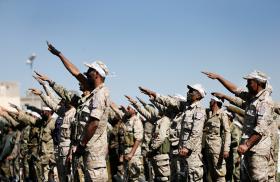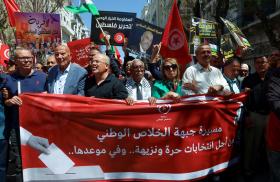- Policy Analysis
- PolicyWatch 4134
Hamas’s “Rigid Pragmatism”: Between Tactical Flexibility and Ideological Intransigence
Gaza stabilization must include precise disarmament rules, independent monitoring, and pressure from Egypt, Qatar, and Turkey to counter Hamas’s blend of flexibility and intransigence.
After the publication of President Donald Trump’s twenty-point plan, many were surprised to see Hamas relinquish some of its ostensibly nonnegotiable demands from the past two years, in particular, by releasing the remaining living hostages without a full Israeli withdrawal from Gaza. This initially created an impression of moderation, which quickly faded when Hamas launched a brutal retaliation campaign against its rivals and redeployed its security forces through the streets of Gaza. The weapons Hamas seized from rival militias further deepened doubts about its commitment to fulfilling the terms imposed by the Trump peace plan—first and foremost, handing over its light weapons and heavy weapons, including rocket-propelled grenades and explosives—and dismantling its military framework.
Hamas’s Strategic Conduct: Rigid Pragmatism
Hamas operates according to rigid pragmatism—a strategy that combines tactical adaptation to shifting realities with uncompromising adherence to ideological principles. This allows it to demonstrate flexibility when doing so serves its long-term goals without abandoning its core tenets: rejection of Israel’s legitimacy, pursuit of dominance in the Palestinian arena, and preservation of armed resistance.
This is not new. In previous years, Hamas made tactical and rhetorical adjustments to signal adaptability to shifting political and security conditions without abandoning its radical, jihadist worldview. In 2017, it published a “Document of General Principles and Policies” that emphasized its nationalist-Palestinian identity and hinted at acceptance of a two-state solution based on the 1967 borders, though not as a final settlement. In early 2024, following the October 7 attacks, Hamas released “Our Narrative,” portraying itself as a national liberation movement rather than a religious one and implying readiness to relinquish control of Gaza to a Palestinian entity—without recognizing Israel or committing to disarmament. In all cases, its core ideological positions remained intact.
Disarmament: Conditional Flexibility, Nonnegotiable Principle
Hamas has not formally committed to the Trump plan, but it has agreed to its first phase—a ceasefire, hostage-prisoner exchanges, and the transfer of authority in Gaza to a Palestinian technocratic committee supported by Arab and Muslim states. The question of disarmament remains vague in Hamas statements and is apparently being deferred to a later stage, contingent on broader Palestinian consensus. Similarly, the Sharm al-Sheikh declaration of October 13, signed by Egypt, Turkey, and Qatar, does not explicitly call to disarm Hamas or remove it from power, instead opting for a general goal “to dismantle extremism and radicalization in all its forms.” The final communiqué of the Palestinian Dialogue, held in Cairo on October 23 and 24 and attended primarily by Fatah and Hamas representatives, also avoided the disarmament issue and focused on establishing the technocratic committee to manage Gaza.
Hamas official Khalil al-Hayya, who lives in Qatar, stated after the Cairo meeting that the group is willing to establish such a committee provided it is not subordinate to the Palestinian Authority (PA) or the PLO and is only a temporary move until general elections and the formation of a Palestinian unity government. He added that Hamas opposes relinquishing its “resistance weapons” as long as “occupation” persists, without entirely rejecting the deployment of a UN force in Gaza to monitor the ceasefire, separate the parties, and secure the borders. Arab sources involved in negotiations with Hamas claim they were led to believe the movement would agree, in the second phase of the Trump plan, to dismantle its “heavy weapons”—primarily rockets and mortars—but not to surrender the personal weapons of its fighters, which it views as defensive.
As in the past, Hamas is expected to show limited and conditional flexibility on the issue of weapons. Its approach will be shaped not only by its ideology and regional dynamics but also by its need to preserve its status within the Palestinian system, especially in Gaza. Hamas is likely to assess whether partial disarmament could help it gain indirect legitimacy to maintain its organizational and political infrastructure in the Strip or enable entry into PLO institutions and participation in future Palestinian elections. For this purpose, it may rely on the legal existence of parties and organizations that are not formally affiliated with it—a method it has employed since the 1990s and one that is common among Muslim Brotherhood groups in the Arab world and the West.
Still, Hamas will be careful not to lose its military dominance in Gaza against other armed militias and rival clans, with which it has clashed extensively in recent weeks, and against PA forces that may be deployed later. For Hamas, retaining its fighters’ personal weapons is a prerequisite for internal control, local deterrence, and protection against being sidelined within the Palestinian system.
Pressures from Qatar and Turkey and Hamas’s Internal Divisions
Pressure from Qatar, Turkey, and other regional actors, who feared that violence from Gaza would spill over into their territories, was a key factor in persuading Hamas to agree to the ceasefire. Hamas understands the cost of clashing with Qatar and Turkey, its main pillars of support. Given the group’s ideological rigidity, it would not likely have agreed to be flexible without clear assurances from those countries, and possibly directly from the United States, that the war would not resume.
A major obstacle to Hamas’s implementation of the second phase of the agreements under the Trump plan is the deep internal rift between the group’s political leadership abroad, primarily in Qatar, and its military wing in Gaza. While the political leaders, led by Khaled Mashal and Khalil al-Hayya, lean toward a rigid pragmatist line and are willing to consider limited and temporary political arrangements, the military wing, aligned with the Iranian axis, opposes any compromise perceived as undermining armed resistance, particularly disarmament. These differences explain Hamas’s conduct—on the one hand, accepting agreements in principle; on the other, obstructing their implementation.
Looking Ahead: Preventing Military Reconstruction Under Political Cover
In the near future, diplomatic efforts will center on refining the draft UN Security Council resolution to mandate the deployment of an international stabilization force in Gaza. A clear and comprehensive policy on disarmament must be established—beginning with precise definitions of what constitutes disarmament and outlining the mechanisms for its implementation, and culminating in a detailed framework for the force’s mandate, authority, and composition. Crucially, the policy must eliminate any loopholes that could enable Hamas to retain heavy weapons by classifying them as light arms or to gradually reconstruct its military infrastructure.
At the same time, it is worth remembering that any international effort to stabilize Gaza must be precise, resistant to circumvention, and grounded in a clear understanding of Hamas’s operational logic. Rigid pragmatism is not a sign of moderation—it is a strategy of survival, power preservation, and gradual consolidation. Even when Hamas agrees to temporary arrangements, it ensures it retains the ability to rebuild its strength—whether through an extended ceasefire (hudna), transitional governments, technocratic committees, or indirect political structures. For Hamas, time is a strategic asset.
Hamas will not disarm voluntarily and will likely manipulate this issue, including through the use of “rogues” and the concealment and repurchase of weapons. Therefore, policy must be designed to constrain its room to maneuver and undermine its ability to maintain military dominance in Gaza. Key measures include establishing independent monitoring mechanisms, disconnecting humanitarian aid from Hamas-controlled governance structures, and promoting alternative Palestinian administrative frameworks that enable effective civilian governance—without incorporating Hamas. It is essential to monitor attempts by Hamas to bypass restrictions through proxies and to condition the group’s political participation on explicit commitment to international principles. At the same time, Turkey and Qatar must continue to apply pressure on Hamas to show flexibility, while Egypt must act through its own mechanisms—mediation and the imposition of clear conditions to contain and limit Hamas’s influence.
Neomi Neumann is a recent visiting fellow at The Washington Institute (2023–2025) who formerly headed the research unit at the Israel Security Agency.


